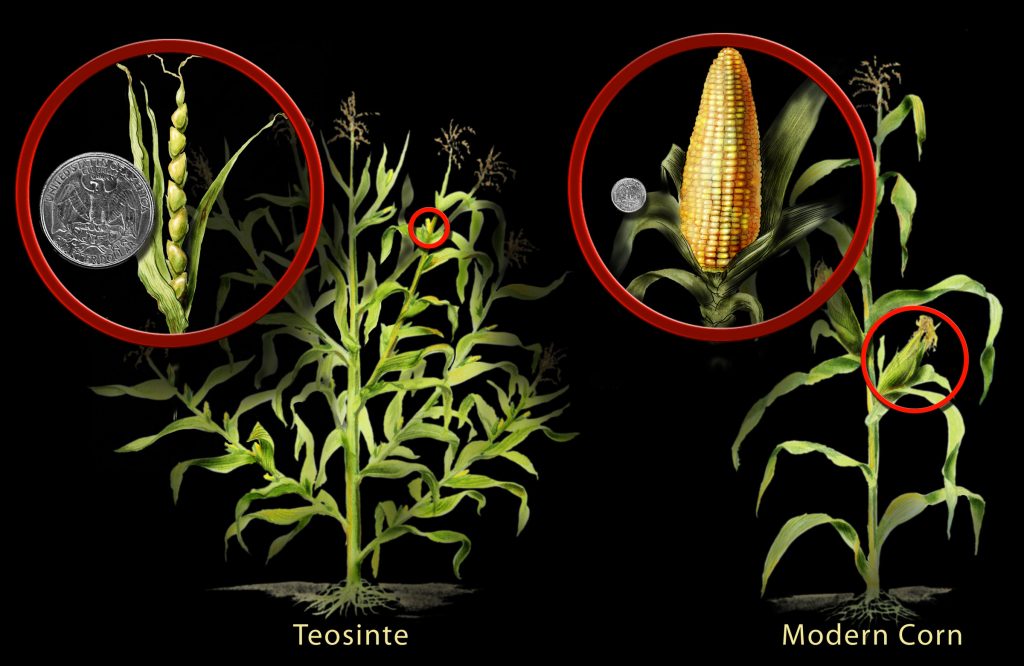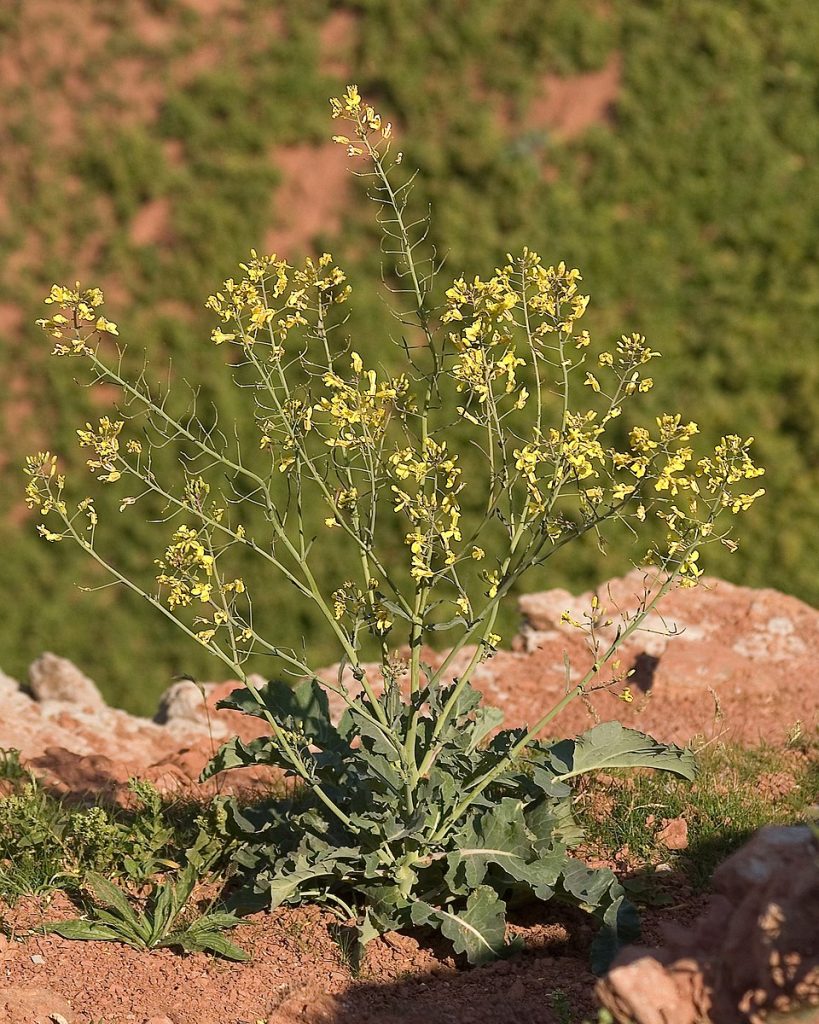2 Chapter 2: Artificial Selection
Lisa Limeri
Learning Objective
By the end of this section, students will be able to:
- List and describe the 3 requirements for selection.
Introduction
Nearly all the fruits and vegetables found in your local market would not occur naturally. In fact, they exist only because of human intervention that began thousands of years ago. Humans created the vast majority of crop species by using traditional breeding practices on naturally-occurring, wild plants. These practices rely upon artificial selection, human-facilitated reproduction of individuals with desirable traits. For example, high yield varieties were produced through selective breeding. Traditional breeding practices, although low-tech and simple to perform, have the practical outcome of modifying an organism’s genetic information, thus producing new traits.
Artificial selection happens when humans determine which individuals in a population have the most desirable traits (e.g., wolves that were less aggressive, strawberry plants that produced larger fruits), and selected those individuals to breed to form the next generation. This process, repeated over time, results in changes in the target population over time (e.g., domesticated dogs and strawberry plants).
An interesting example is maize (corn). Biologists have discovered that maize was developed from a wild plant called teosinte. Through traditional breeding practices, humans living thousands of years ago in what is now Southern Mexico began selecting for desirable traits until they were able to transform the plant into what is now known as maize (Figure 2.1). In doing so, they permanently (and unknowingly) altered its genetic instructions.

This history of genetic modification is common to nearly all crop species. For example, cabbage, broccoli, brussels sprouts, cauliflower, and kale were all developed from a single species of wild mustard plant (Figure 2.2).

Three Requirements of Selection
There are three conditions that are required for selection: variation, heritability, and differential reproduction.
Variation
We call the diversity of alleles and genotypes within a population genetic variance. Selection can only take place if there is variation, or differences, among individuals in a population. For example, if all of the strawberry plants in a population produce the same amount of fruits of the same size, then there is no basis upon which to select. More desirable traits only exist when there is variation in the trait. A population’s individuals often display different phenotypes, or express different alleles of a particular gene, which scientists refer to as polymorphisms. We call populations with two or more variations of particular characteristics polymorphic. A number of factors, including the population’s genetic structure and the environment influence population variation, the distribution of phenotypes among individuals. Understanding phenotypic variation sources in a population is important for determining how a population will respond to selective pressure. Genetic diversity in a population comes from two main mechanisms: mutation and sexual reproduction. Mutation, a change in DNA, is the ultimate source of new alleles, or new genetic variation in any population.
Conservation biologists who design breeding programs in zoos typically try to maintain a population’s genetic variance to preserve as much of the phenotypic diversity as possible. This also helps reduce associated risks of inbreeding, the mating of closely related individuals, which can have the undesirable effect of bringing together deleterious recessive mutations that can cause abnormalities and susceptibility to disease. For example, a disease that is caused by a rare, recessive allele might exist in a population, but it will only manifest itself when an individual carries two copies of the allele. Because the allele is rare in a normal, healthy population with unrestricted habitat, the chance that two carriers will mate is low, and even then, only 25% of their offspring will inherit the disease allele from both parents. While it is likely to happen at some point, it will not happen frequently enough for natural selection to be able to swiftly eliminate the allele from the population, and as a result, the allele maintains itself at low levels in the gene pool. However, if a family of carriers begins to interbreed with each other, this will dramatically increase the likelihood of two carriers mating and eventually producing diseased offspring, a phenomenon called inbreeding depression.
Reading Question #1
What is the ultimate source of genetic variation in a population?
A. Mutations
B. Genetic engineering
C. Polymorphisms
D. Natural selection
Heritability
Selection can only act on heritable traits, namely those that are genetically encoded. This is critical because non-genetic factors can cause variation among individuals, such as an individual’s height because of better nutrition rather than different genes. Acquired traits, for the most part, are not heritable. For example, if an athlete works out in the gym every day, building up muscle strength, the athlete’s offspring will not necessarily grow up to be a body builder. If there is a genetic basis for the ability to run fast, on the other hand, a parent may pass this to a child. Heritability is the fraction of phenotype variation that we can attribute to genetic differences, or genetic variance, among individuals in a population. The greater the heritability of a population’s phenotypic variation, the more susceptible it is to the evolutionary forces that act on heritable variation.
Not all variation observed within a species in heritable, some variation is caused by environmental factors. Someone who spends a lot of time outdoors without sun protection will have darker skin than someone with the same alleles who has minimal exposure to UV rays because humans increase melanin production in response to UV exposure. This is not to be confused with variations in melanization due to different alleles, which also exists. Sun tans will not be passed on to the next generation, but alleles influencing melanin production will. For some species, the environment determines some major characteristics, such as sex. For example, some turtles and other reptiles have temperature-dependent sex determination (TSD). TSD means that individuals develop into males if their eggs are incubated within a certain temperature range, or females at a different temperature range.
Reading Question #2
What makes a trait heritable?
A. It is environmentally-based.
B. It is genetically-based.
C. It is beneficial for survival.
D. It is variable.
Differential Reproduction
When humans only allow individuals with desirable traits to reproduce, the next generation consists of offspring who inherit the desirable trait from their parents. In artificial selection, humans determine which individuals reproduce.
Reading Question #3
What are the 3 conditions under which selection will occur?
A. Heritability of traits, differential survival, and ongoing evolution
B. Differential survival, differential reproduction, and differential heritability
C. Uniformity of traits, uniform survival, and uniform heritability
D. Heritability of traits, differential reproduction, and variability of traits
The Result of Selection is Changes in Allele Frequency in a Population
Recall that a gene for a particular character may have several alleles, or variants, that code for different traits associated with that character. For example, in the ABO blood type system in humans, three alleles determine the particular blood-type carbohydrate on the surface of red blood cells. Each individual in a population of diploid organisms can only carry two alleles for a particular gene, but more than two may be present in the individuals that comprise the population. Mendel followed alleles as they were inherited from parent to offspring. In the early twentieth century, biologists in the area of population genetics began to study how selective forces change a population through changes in allele and genotypic frequencies.
The allele frequency (or gene frequency) is the rate at which a specific allele appears within a population. Behind the phenotypic change we see in artificial selection is genetic change. In population genetics, scientists define the term evolution as a change in the allele’s frequency in a population. Using the ABO blood type system as an example, the frequency of one of the alleles, IA, is the number of copies of that allele divided by all the copies of the ABO gene in the population. For example, a study in Jordan identified the allele frequencies of the three alleles for blood type: IA allele frequency was 26.1%; IB allele frequency was 13.4%; and I0 allele frequency was 60.5%. All of the frequencies add up to 100%. A change in this frequency over time would constitute evolution in the population.
The allele frequency within a given population can change depending on environmental factors; therefore, certain alleles become more widespread than others during the selection process. Selection can alter the population’s genetic makeup. An example is if a given allele confers a phenotype that humans deem to be desirable and humans select that individual to reproduce more than others. Over time, the allele will spread throughout the population. Some alleles will quickly become fixed in this way, meaning that every individual of the population will carry the allele, while detrimental mutations may be swiftly eliminated from the gene pool. The gene pool is the sum of all the alleles in a population.
Reading Question #4
Which of the following describes an allele?
A. A trait that makes an organism valuable to humans.
B. A trait that is influenced by the environment.
C. Variations of a particular gene.
D. A trait that has no variation.
Reading Question #5
What is the result of artificial selection?
A. New mutations arise
B. Variation in the population increases
C. Allele frequency changes
D. All of the above.
Summary
Variation in a trait is caused by the existence of alleles for a given gene existing in a population. When humans find one allele beneficial, they may choose to selectively breed individuals who carry that allele. Thus, individuals carrying the beneficial allele pass it onto the next generation more successfully than individuals with the less beneficial allele; and the beneficial allele becomes more frequent in the next generation. The next generation then has a higher frequency of the beneficial trait due to this underlying change in allele frequency.
References
Adapted from Clark, M.A., Douglas, M., and Choi, J. (2018). Biology 2e. OpenStax. Retrieved from https://openstax.org/books/biology-2e/pages/1-introduction
diversity of alleles and genotypes in a population
also known as alternative phenotypes, polymorphisms are occurrence of different forms of a species due to genetic variation.
variation in the nucleotide sequence of a genome that occur at constant rates - they may be spontaneous or induced.

